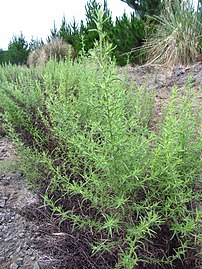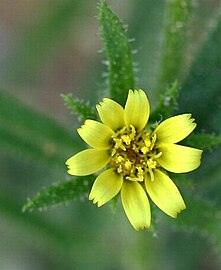
The family Asteraceae, with the original name Compositae, consists of over 32,000 known species of flowering plants in over 1,900 genera within the order Asterales. Commonly referred to as the aster, daisy, composite, or sunflower family, Compositae were first described in the year 1740. The number of species in Asteraceae is rivaled only by the Orchidaceae, and which is the larger family is unclear as the quantity of extant species in each family is unknown.

Senecio vulgaris, often known by the common names groundsel and old-man-in-the-spring, is a flowering plant in the family Asteraceae. It is an annual herb, native to the Palaearctic and widely naturalised as a ruderal species in suitable disturbed habitats worldwide.

Echium plantagineum, commonly known as purple viper's-bugloss or Patterson's curse, is a species of the genus Echium native to western and southern Europe, northern Africa, and southwestern Asia. It has also been introduced to Australia, South Africa, and United States, where it is an invasive weed. Due to a high concentration of pyrrolizidine alkaloids, it is poisonous to grazing livestock, especially those with simple digestive systems, such as horses.

Bidens frondosa is a North American species of flowering plant in the aster family, Asteraceae. It is widespread across much of Canada, the United States, and Mexico It is known in many other parts of the world as an introduced species, including Europe, Asia, Morocco, and New Zealand. Its many common names include devil's beggarticks, devil's-pitchfork, devil's bootjack, sticktights, bur marigold, pitchfork weed, tickseed sunflower, leafy beggarticks, and common beggar-ticks.

Inula is a genus of about 80 species of flowering plants in the family Asteraceae, native to Europe, Asia and Africa.

Erigeron bonariensis is a species in the family Asteraceae, found throughout the tropics and subtropics as a pioneer plant; its precise origin is unknown, but most likely it stems from Central America or South America. It has become naturalized in many other regions, including North America, Europe and Australia. Common names include flax-leaf fleabane, wavy-leaf fleabane, Argentine fleabane, hairy horseweed, asthma weed and hairy fleabane.

Elymus repens, commonly known as couch grass, is a very common perennial species of grass native to most of Europe, Asia, the Arctic biome, and northwest Africa. It has been brought into other mild northern climates for forage or erosion control, but is often considered a weed.

Cirsium arvense is a perennial species of flowering plant in the family Asteraceae, native throughout Europe and western Asia, northern Africa and widely introduced elsewhere. The standard English name in its native area is creeping thistle. It is also commonly known as Canada thistle and field thistle.

Crepis capillaris, the smooth hawksbeard, is a species of flowering plant in the tribe Cichorieae within the family Asteraceae, and is native to Europe. It has become naturalized in other lands and is regarded as a weed in some places.
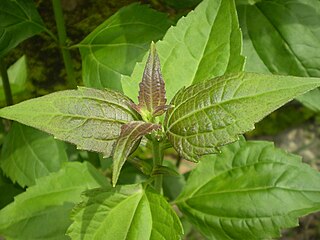
Chromolaena odorata is a tropical and subtropical species of flowering shrub in the family Asteraceae. It is native to the Americas, from Florida and Texas in the United States south through Mexico and the Caribbean to South America. It has been introduced to tropical Asia, West Africa, and parts of Australia.

Delairea odorata is a climber within the family Asteraceae that is native to South Africa. One of the two species in the genus Delairea, it was previously included in the genus Senecio as Senecio mikanioides. It is known as Cape ivy in some parts of the world (US) and German ivy in others. Other names include parlor ivy and Italian ivy.
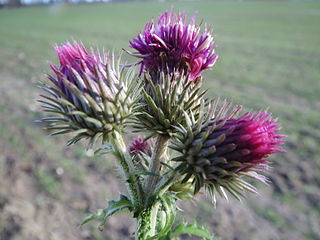
Carduus acanthoides, known as the spiny plumeless thistle, welted thistle, or plumeless thistle, is a biennial plant species of thistle in the family Asteraceae. The plant is native to Europe and Asia and introduced in many other areas, where it is sometimes considered an invasive species.
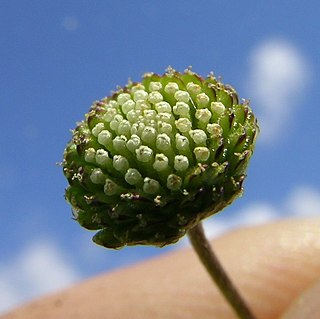
Cotula australis is a species of plant in the daisy family known by the common names bachelor's buttons, annual buttonweed, southern waterbuttons and Australian waterbuttons. This small plant is native to Australia and New Zealand, but it is known in other areas of the world as a common weed.

Crupina vulgaris is a species of flowering plant in the family Asteraceae. Its common names include common crupina, bearded-creeper, false saw-wort, and starry scabious. It is native to parts of Europe, Asia, and North Africa, and it is known elsewhere as an introduced species and often a noxious weed.

Echinops sphaerocephalus, known by the common names glandular globe-thistle, great globe-thistle or pale globe-thistle, is a Eurasian species of globe-thistle belonging to the tribe Cardueae within the family Asteraceae.

Brickellia greenei is a species of flowering plant in the family Asteraceae known by the common name Greene's brickellbush. It is native to the mountain ranges of southwestern Oregon and northern California, including the Cascades, the northern Coast Ranges, and Sierra Nevada.
Calycadenia truncata is a species of flowering plant in the family Asteraceae known by the common name Oregon western rosinweed. It is native to western North America.

Dittrichia is a genus of flowering plants in the daisy family. Its species were formerly included in the genus Inula.

Dittrichia viscosa, also known as false yellowhead, woody fleabane, sticky fleabane and yellow fleabane, is a flowering plant in the daisy family.

Crepis tectorum, commonly referred to as the narrowleaf hawksbeard or narrow-leaved hawk's-beard, is an annual or winter annual plant between 30 and 100 centimetres in height. Originating in Siberia before being introduced to Canada in 1890, the narrowleaf hawksbeard's is an invasive species. Maintaining one branched, hairless and leafy stem during maturity, the narrowleaf hawksbeard has yellow leaves which are arranged in an alternate manner and less than 0.5 inches (13 mm) wide.

